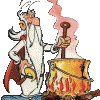14 hours ago, kayb said:On 4/26/2016 at 2:18 AM, huiray said:Herbal duck soup.
Stuff for the soup.
Left-to-right: Mountain yam slices, Angelica sinensis root slices, tangerine peel pieces, wolfberries, Codonopsis pilosula root pieces, Angular Solomon's Seal rhizome slices, longan flesh, Szechuan lovage root slices.
I've listed their Chinese names and more info on the herbs/roots elsewhere on eG - look up bak kut teh posts or older duck soup posts, for example.
I am intrigued by the mountain yam slices. Do they taste similar to regular yams? I've never seen them; are they grown in the US?
When you say "regular yams" do you mean actual yams (usually found in international and "ethnic" markets) or do you mean the soft-fleshed sweet potato that in the US has been commonly called "yams"? (See here, here)
In any case, As I mentioned in my post I listed links and further info in older posts of mine regarding the roots & herbs I used. Do look them up. But for this specific ingredient ("Mountain Yam") try this post, or this one. This ingredient (淮山) is also called "Chinese Yam" and I've referred to it as such as well. For interest, the character 淮 refers to (and means) a particular river in Henan & Anhui provinces in mainland China. The character 山 means "mountain". The binary Latin name for it has been "updated", from Dioscorea opposita to Dioscorea polystachya.
The equivalent Japanese name is "Nagaimo" - perhaps you might know it better as that?
These are dried slices of the yam. Available in well-stocked Chinese groceries and Chinese or other E/SE Asian "Medicine Shops". When cooked they are not slimy at all. In contrast, if one finely ground the fresh yam one can get a slimy mound of stuff - but which is used (and appreciated) in its own way in these cuisines. Eating-wise – they (the cooked dried slices) are, uhh, "yam-my"... there is a sort of powdery but firm texture to it, not unlike slices of some starch-heavy large potatoes when freshly cooked. There is little inherent taste to them other than a "starchy" taste. They are there more for the texture contrast, complementarity and carb content, if one is not concerned with their reported medicinal benefits.
They would seem to be grown here in the USA also, from prior introduction of the plants - but I've certainly never seen them in Western-style markets/supermarkets. I imagine they are grown for the E/SE Asian populations here. The fresh tubers are available regularly in my usual Chinese grocery, for example.
Fresh 淮山 yams are similar to the native Japanese variant, "Yamaimo", available in Japanese groceries.






